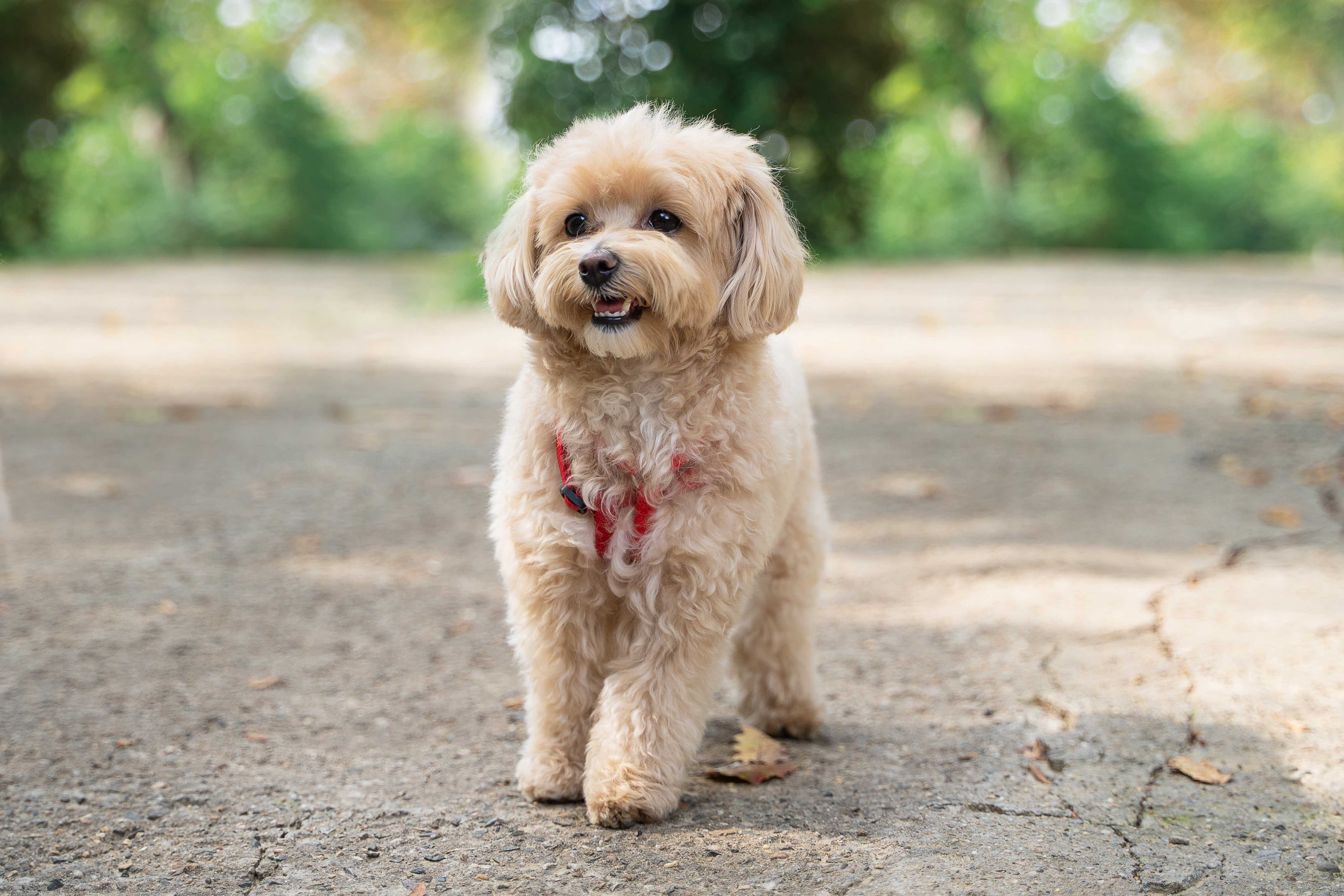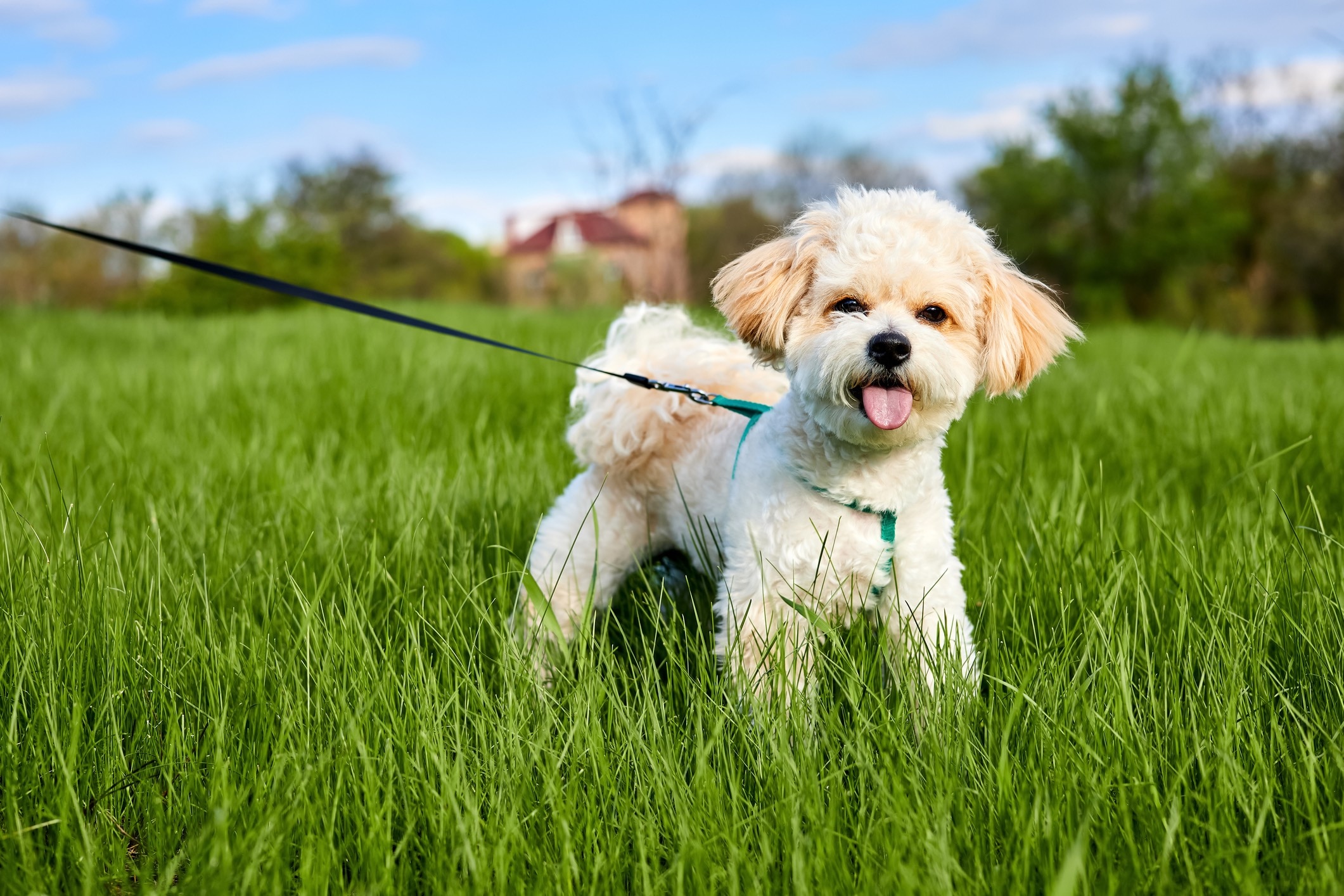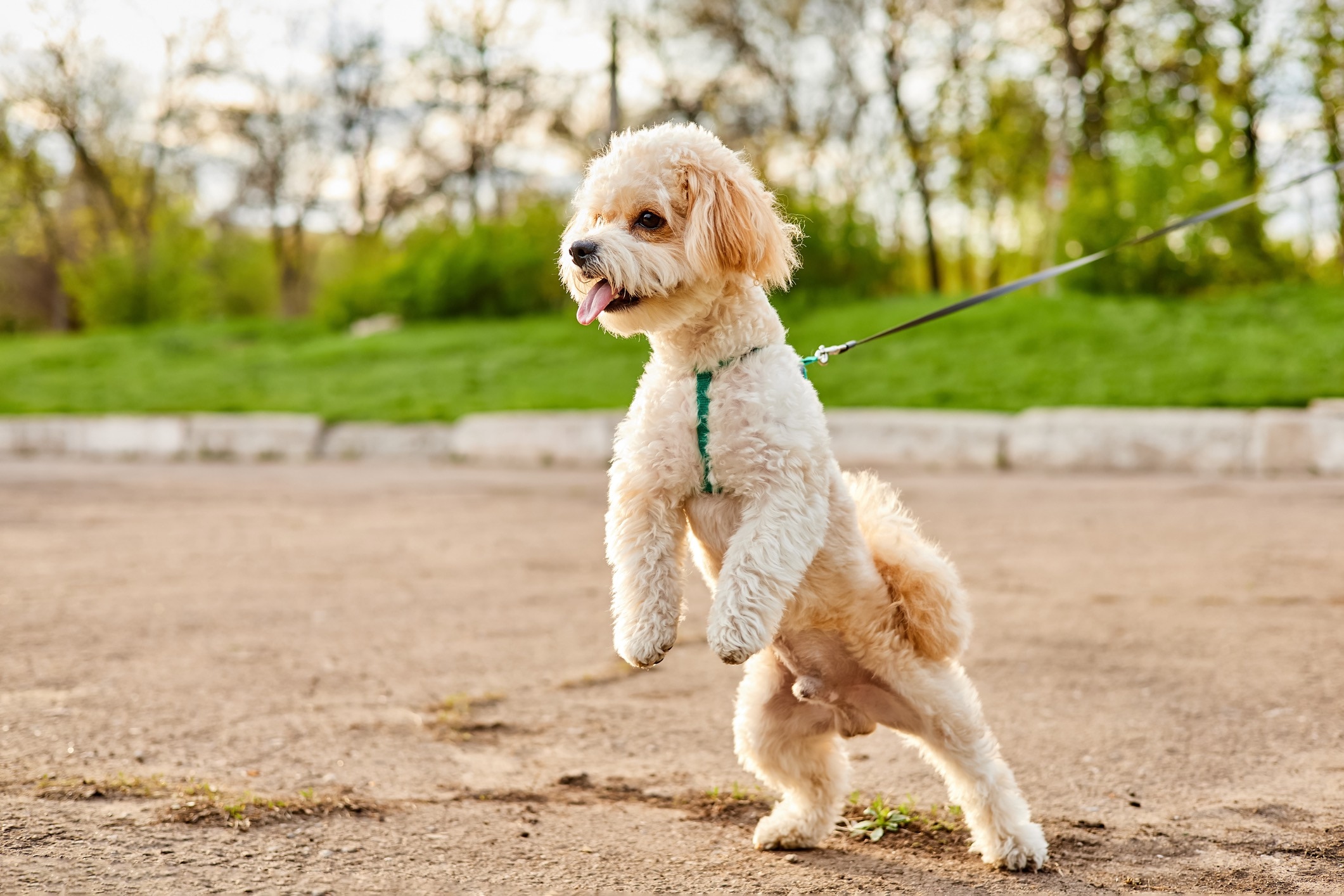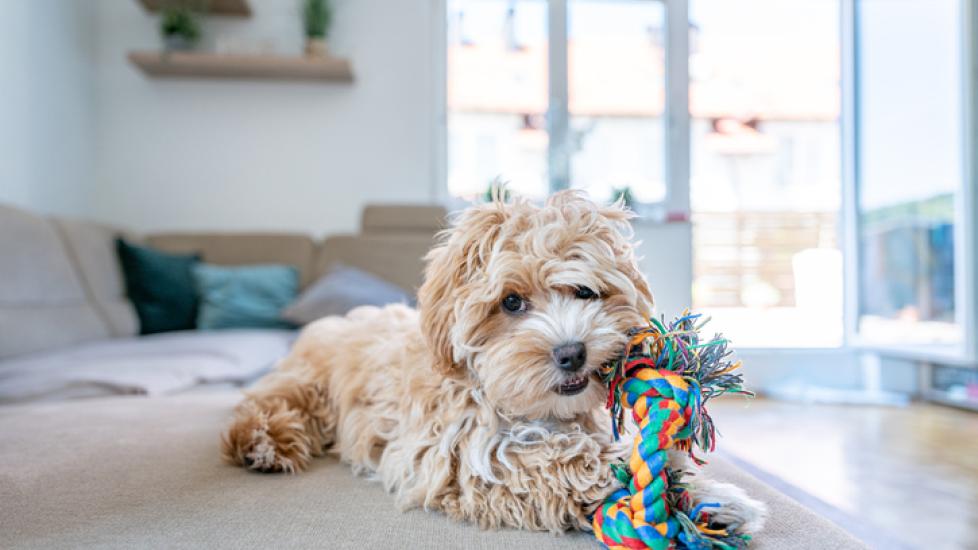Maltipoo
Known for their well-mannered and charming personalities (not to mention their adorable appearance), Maltipoos are a cross between a Maltese and a Toy or Miniature Poodle. Bouncy and small in stature, Maltipoos can be great companions for apartment dwellers, older adults, families with small kids, and everyone in between. Full-grown Maltipoos stand 8–14 inches tall and weigh 10–20 pounds.
Caring for a Maltipoo

Maltipoos are playful and intelligent dogs, but they don’t have the always-on-the-go mentality of some other breeds. A daily walk and some backyard play sessions can help exert some of their balled-up energy.
Maltipoos are fun companions who love their humans, says Pam Nichols, DVM, CCRP, CFI, past president of the American Animal Hospital Association. But they also don’t know just how small and cute they really are; Maltipoos often try to act like a watchdog, barking to alert their family if they see or hear something unfamiliar.
That said, Maltipoos are eager to make their humans happy. And with dedicated positive reinforcement training, Maltipoos can learn good manners and remain puppy-like for the entirety of their life—about 13–16 years.
Maltipoo Health Issues
Before you consider adding a Maltipoo puppy to your home, you should know about the potential health issues this breed may encounter. Nichols says Maltese-Poodle mixes can experience a handful of health issues, making pet insurance a smart investment.
Patellar Luxation
A common health issue in Maltipoos, luxating patella is when a dog’s kneecap is not correctly aligned and slips out of place. This health issue can be startling to Maltipoo parents, as their pup might act normal one moment, and then be in pain and limping the next. Dogs with luxating patellas often have a characteristic bunny hop to their gait. The condition sometimes corrects itself, but surgery may be required in severe cases. If untreated, luxating patellas lead to chronic pain and arthritis.
Dental Disease
Like many other small dog breeds, Maltipoos are prone to periodontal disease, or gum disease. This is when bacteria in their mouth causes receding gums, bone resorption, and tooth loss.
“Everyone who owns a Maltipoo needs to teach their dog how to have their teeth cleaned,” Nichols says. “Every tooth, every surface, every day.” Pet parents need to brush their dog’s teeth with dog-specific toothpaste. Starting this routine when your Maltipoo puppy is young will help them grow used to it as they age.
“Maltipoos should never have bad breath,” Nichols continues. “The smell of bad breath means bacteria is present. You can keep bacteria down by brushing your dog’s teeth daily from puppyhood.”
Legg-Calvé-Perthes Disease
Legg-Calvé-Perthes disease primarily affects small dog breeds and is caused by disrupted blood flow to the leg/hip. This causes blood clots and bone deterioration, accompanied by pain and lameness. If you notice your Maltipoo is limping or holding up a leg, call your veterinarian.
Epilepsy
Epilepsy is a predisposed neurological condition that can be found in Maltipoos. Pet parents need to be vigilant for signs of seizures in dogs, including:
-
Collapse
-
Becoming stiff
-
Paddling the limbs
-
Suddenly urinating or defecating
For some Maltipoo dogs, an epileptic seizure might only happen once or twice in their lifetime, but it can be a recurring issue for others. Most dogs with epilepsy can live a normal life with medication.
What To Feed a Maltipoo

It’s essential to feed Maltipoo puppies and adults a healthy, balanced diet. When choosing the best dog food for your Maltipoo, select a brand approved by the Association of American Feed Control Officials (AAFCO). This will ensure their digestive system stays healthy, their teeth remain strong, and their coats stay shiny.
How To Feed a Maltipoo
It’s important to feed your Maltipoo puppy on a regular schedule three or four times a day. As they grow, you can scale back and feed your dog two or three small meals a day.
How Much Should You Feed a Maltipoo?
Maltipoos are a small breed that can easily become obese, so pet parents need to monitor their dog’s caloric intake to ensure they’re staying at a healthy weight. Always measure the food you give your pet. The dog food container will have guidance as to the proper amounts, but talk with your veterinarian to learn just how much you should be feeding your dog.
Nutritional Tips for Maltipoos
Most dogs get the nutrients they need from their dog food. But if your vet recommends nutritional supplements, Maltipoos may benefit from ones that support joint health.
Behavior and Training Tips for Maltipoos
Maltipoo Personality and Temperament

Maltipoos are friendly, outgoing dogs. They are gentle with kids, adults, seniors, and other pets—as long as they’ve been properly socialized. While Maltipoos make great companions for single people or families, they can experience separation anxiety if left alone for too long. Before bringing home a Maltipoo puppy, make sure you have ample time to dedicate to them.
Maltipoo Behavior
Maltipoos are sensitive and thrive with a routine and a controlled environment. They do best in homes where they are surrounded by their families most of the day and, if they must be left alone for a bit, they should be crate-trained to help them feel safe.
These little Maltese-Poodle mixes can be particularly barky, too, and will sound off to let you know when there is anything outside, from the mail carrier to a neighborhood squirrel. So while their small size makes Maltipoos a good fit for apartment living, your next-door neighbors might not appreciate the noise.
Maltipoo Training
Training a Maltipoo is easy, thanks to the breed’s eager-to-please nature and intelligence. Always use positive reinforcement methods when training, but stay mindful of how many treats you’re giving your pup; these calories can add up quickly. Try rewarding your Maltipoo with praise and toys to avoid giving them too many treats.
Fun Activities for Maltipoos
-
Playing fetch
-
Chase
-
Tug of war
-
Hide and seek
Maltipoo Grooming Guide
While they don’t shed as much as many other dog breeds, Maltipoos are a high-maintenance breed that must be regularly groomed to maintain their appearance, says Renee Faust, a certified master groomer with the National Dog Groomers Association of America and groomer at Renee’s Dog Grooming.
Remember that every Maltipoo coat differs, so their exact grooming needs may vary.
Skin Care
To ensure that your Maltipoo’s skin remains healthy, get them professionally groomed every four to six weeks. Faust says regular bathing and brushing are two of the most important tasks when caring for a Maltipoo. These two steps help prevent skin infections and matting fur.
"Brushing your Maltipoo every day is essential,” Faust says. “If their coat mats up, it becomes tight, and you won't be able to brush them out at home without hurting them.”
Coat Care
A Maltipoo’s coat can be curly like their Poodle parent, or straight and silky like their Maltese parent. Most Maltipoos have all-white fur, but their coats can come in other colors, too, including black, gray, cream, brown, and gold.
No matter what your Maltipoo looks like, they need to be brushed daily with a wire slicker brush. Pet parents who want a lighter routine can enlist a groomer to give their dog a cute Maltipoo haircut like the short, so-called “puppy cut.” This makes their coat easier to maintain, but they will still need regular trips to the groomer for face framing, nail trims, and other upkeep.
Eye Care
Maltipoo puppies can be born with plugged tear ducts, which may cause tear stains as they age. Pet parents can wipe their Maltipoo’s eyes with a pet-friendly eye cleaner as needed to clean off any tear staining. Alternatively, to help prevent the tear stains, “you can have a simple cosmetic procedure done on your Maltipoo puppy to open the tear ducts,” Nichols says.
Ear Care
Ear infections are common in Maltipoos, thanks to the hair that grows in their ears. If their ears are not cleaned regularly, you’ll find a buildup of fur and wax inside. By cleaning their ears after bath time or ensuring that the groomer cleans them, you can help prevent infections.
Considerations for Pet Parents

Adding a dog to the family, even one as small as a Maltipoo, is a big decision that shouldn’t be taken lightly. Before bringing home a Maltipoo puppy, ask yourself if you’re able to give them the right environment that Maltese-Poodle mixes need. Are you a homebody? Do you work from home? Can someone be with the pup most of the day?
If the answer to these questions is no, consider a breed that’s a little more independent than the Maltipoo. These social pups thrive in homes where they are doted on and never left alone for long.
Maltipoo FAQs
How big do Maltipoos get?
Maltipoos are small dogs that only grow to stand 8-14 inches tall and weigh about 10–20 pounds.
How long do Maltipoos live?
The average Maltipoo lifespan is 13–16 years. This is the typical lifespan for small dogs.
How much do Maltipoos cost?
Purchasing a Maltipoo puppy from a reputable breeder can cost anywhere between $1,000–$4,000, depending on the breeder, bloodline, location, and other factors. Along with the initial fees for bringing home your pup, pet parents must budget for routine healthcare and regular grooming appointments.
Is a Maltipoo hypoallergenic?
As a mix between a Maltese and Poodle, Maltipoos are commonly considered to be hypoallergenic. However, there is no such thing as a truly hypoallergenic dog, as all pets still shed allergens even if they don’t shed much fur. If you or a family member is allergic to dogs, there is no guarantee a Maltipoo won’t make your allergies flare up. Always spend time with a dog breed to see how you react before bringing one home.
Featured Image: iStock/ti-ja
